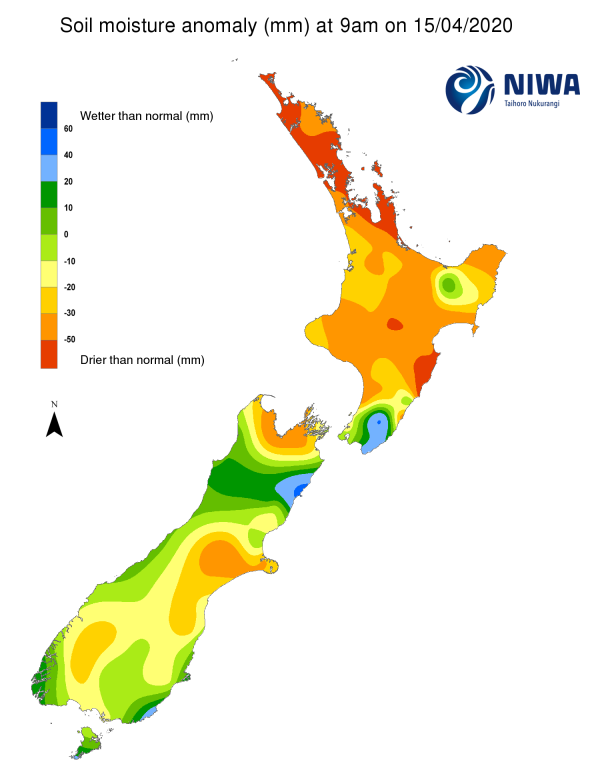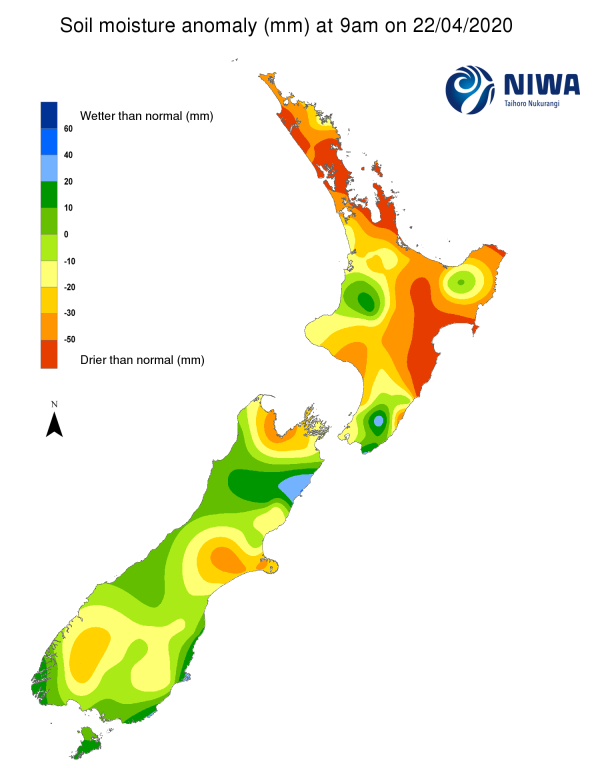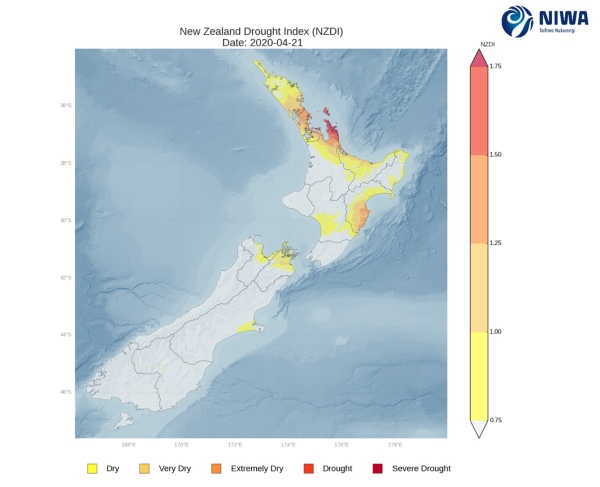A weekly update describing soil moisture patterns across the country to show where dry to extremely dry conditions are occurring or imminent. Regions experiencing significant soil moisture deficits are deemed “hotspots”. Persistent hotspot regions have the potential to develop into drought.
Facts: soil moisture
In the North Island, substantial rainfall of 30 mm or more was observed in the past week across much of western and southern Waikato, parts of Taranaki, the Far North, and isolated parts of eastern Bay of Plenty and northern Wellington. For most other areas rainfall totals were approximately 10-25 mm, although little if any rain fell along the east coast of the North Island. This resulted in moderate soil moisture increases in the western North Island and in the Far North, while soil moisture decreases were observed along the east coast and Wairarapa. Little if any change was seen elsewhere. The driest soils across the North Island, when compared to normal for this time of the year, are located across parts of the upper North Island, much of Hawke’s Bay, and the tip of East Cape. Meanwhile, the wettest soils for this time of the year are located in Wairarapa. The New Zealand Drought Index (NZDI) shows that meteorological drought and severe meteorological drought remain in place across much of the Coromandel Peninsula and a small part of northern Auckland (see NZDI map).
Hotspots are currently found across parts of western Northland, northern Auckland, the Coromandel Peninsula, southern Hastings, Central Hawke’s Bay, and a part of coastal Manawatu-Whanganui.
In the South Island, rainfall of 75 mm or more was observed along much of the West Coast during the past week, with 30 mm or more in much of Tasman, Buller District, and a few areas near and north of Dunedin. Many other locations saw rainfall totals in the 10-25 mm range, while northern Canterbury and eastern Marlborough received only minimal rainfall. Many parts of the South Island saw small soil moisture increases during the past week, although small decreases were observed in northern Canterbury. The driest soils in the South Island compared to normal for this time of the year are located in Nelson, nearby parts of Tasman and Marlborough, and parts of central Canterbury, while the wettest soils for this time of the year are found in Kaikoura. The NZDI shows that meteorological drought is not found in the South Island, although drier than normal conditions are still present in the top of the South Island and parts of central Canterbury (see NZDI map).
Currently, the only official hotspot in the South Island is found in coastal Selwyn and Ashburton districts.
Outlook and soil moisture
In the North Island, a swath of heavy rain will bring isolated accumulations up to 25 mm in parts of Northland through Friday morning (24 April), while other western areas will see more modest amounts of 10 mm or less. Thereafter, several days of mostly if not entirely dry weather are expected through the middle of next week as high pressure builds overhead. With the exception of Northland, many parts of the North Island will see rainfall totals during the next week of 10 mm or less, and in fact parts of the east coast may receive no rainfall at all.
The expected dry weather over the next week will result in widespread minor to moderate soil moisture decreases, although increases will be possible in parts of Northland. All North Island hotspots are likely to strengthen during the next week, with the exception of Northland, where additional improvements are possible.
In the South Island, heavy rain is affecting parts of the northern West Coast today (23 April), although little rain is expected elsewhere through Friday. A series of fronts will impact the West Coast with moderate to heavy rain from Saturday through Tuesday (25-28 April), with totals of 20-40 mm possible in the lower South Island as well. By the middle of next week, high pressure will arrive with dry weather. Once again, total rainfall amounts across Marlborough and Canterbury are expected to be meagre during the next week, with many locations receiving less than 10 mm.
While soil moisture increases will be possible in the lower South Island during the next week, expect further decreases across Marlborough and Canterbury. This will likely result in an expansion of the hotspot currently located in central Canterbury, and a new hotspot in eastern Marlborough will also be possible.
Background:
Hotspot Watch: a weekly advisory service for New Zealand media. It provides soil moisture and precipitation measurements around the country to help assess whether extremely dry conditions are imminent.
Soil moisture deficit: the amount of water needed to bring the soil moisture content back to field capacity, which is the maximum amount of water the soil can hold.
Soil moisture anomaly: the difference between the historical normal soil moisture deficit (or surplus) for a given time of year and actual soil moisture deficits.
Definitions: “Extremely” and “severely” dry soils are based on a combination of the current soil moisture status and the difference from normal soil moisture (see soil moisture maps).
Hotspot: A hotspot is declared if soils are "severely drier than normal" which occurs when Soil Moisture Deficit (SMD) is less than -110 mm AND the Soil Moisture Anomaly is less than -20 mm.
Pictured above: soil moisture anomaly maps, relative to this time of year. The maps show soil moisture anomaly for the past two weeks.
As of 21 April, the New Zealand Drought Index (NZDI) map below shows that meteorological drought and severe meteorological drought remain in place across much of the Coromandel Peninsula and a small part of northern Auckland. Meteorological drought is no longer found in the South Island. Please note: some hotspots in the text above may not correspond with the NZDI map. This difference exists because the NZDI uses additional dryness indices, including one which integrates the rainfall deficit over the past 60 days. Changes are therefore slower to appear in the NZDI compared to soil moisture anomaly maps that are instantaneously updated.




